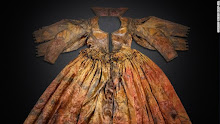“In
the 18th century, metallic fabrics were made with actual metal woven
into the fabrics,” explained Terry in Variety
magazine. “When you put [the original costumes] in a room filled with candles, they just glow.
They’re quite remarkable.” By incorporating delicate shavings of iridescent mica as well as an old, time-consuming embroidery technique using metal strands, Terry was able to be true to the spirit of the era while also creating something stunning and shimmering for Claire’s “reluctant” wedding ceremony.
Reading about the Outlander’s costume
designer’s wish for Claire and her gown to glow,
I thought of Regena Thomashauer, best-selling author and founder of the School of Womanly
Arts in New York City. The heart of Regena’s work encourages women to find
and express their true desires, their self-love, their inner and outer goddess,
their glow. “Glow creates beauty in
women of all ages, all body types, all backgrounds.” And when you glow, you not
only want to dress to show it off, but you just naturally attract and inspire
what’s beautiful in others.
Is
that the reason women are so attracted to the fairy-tale quality of “being
a bride”? The masculine power grid of modern culture doesn’t really encourage the rich, deep, loving expression of feminine values, so a woman’s
wedding becomes a rather rare opportunity for her to glow; a time for
full-tilt-boogie radiance! But I would
encourage all women, every day—no matter where you are in your life—to open your heart, to shine your inner light, to choose radiance!
 |
| Claire and Jamie's candlelit wedding in Outlander (All images from costume designer Terry Dresbach's blog) |





















